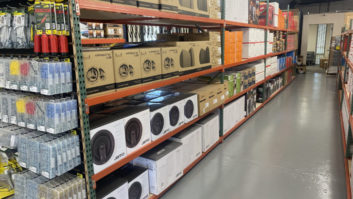Once there was an electronics Camelot era, when computers were bigger than DeSotos, the Internet a gleam in Al Gore’s eye, and people devoted time to music. (Specifically those people were college students, who shopped Wednesday afternoon when classes ended at 11:55 am, and all of Thursday when they cancelled Chem Lab.)
Hunkering down with Stereo Review and Popular Electronics, in ancient days preceding PCs or video games, technologically gifted consumers obsessed over Hi-Fi. They spent hours at Tech Hi-Fi, Sound Advice, Playback, or Pacific Stereo listening to speaker nuances, memorizing amplifier specifications, and generally driving floor sales people crazy.
In those days company X was a middle of the road electronics line, competing with Pioneer, Kenwood, Sansui, and others. This was so long ago Sony was a television brand not into hi-fi. As music reproduction evolved into the 1970’s, company X benefited from the growth in the vastly superior format that followed vinyl LP records – no, not CD, open reel recording!
Here was a medium that recorded beyond human audible range, thus increasing realism by capturing harmonics. Any neighborhood engineer worth his pocket protector made party tapes on open reel machines and played Bach’s Toccatta until the centerpiece vibrated off the dining room table.
Four-track, later eight-track, tape recorders offered convenience, but feeble frequency response, quitting at 10,000 cycles when open reel soared to triple that level. Cassettes had more convenience still, small size without the annoying “thunk” when the track changed. But even after sonic advancements like Dolby B, Dolby C, or Dolby HX, open reel remained the queen of recording for many years. Company X made great open reel product equal to Revox or Docorder.
Unfortunately they didn’t make “great” much anything else. There was a narrow line of middling receivers, cassette decks, and loudspeakers. Without their competitor’s breadth of product, company X never became a widely accepted brand commanding Tier 1 dealer support.
Facing faltering retail interest, the U.S. marketing team stalked Price Club, Sam’s Club and Costco as retail outlets in the 1980’s.
Warehouse clubs worked on 10 percent margins and didn’t negotiate ruthlessly for low acquisition cost at this time. Their goal was to acquire recognizable, branded items that captured consumer attention. The theory went that once in the store customers would buy 55-gallon drums of peanut butter, tires, whole sides of beef, and last year’s paperbacks. Adding the Company X brand itself became a traffic builder. Club’s short margins automatically made prices appealing, so club buyers sought product over price, brand over value.
Company X embraced this channel wholeheartedly, believing it would make their merchandise more appealing versus competitors. A Fisher double cassette deck might sell for $149 and cost $105. Company X’s model cost $119 and normally retailed for $179. But clubs would sell it for $139, plus no advertising to trouble regular dealers – a perfect solution!
Charge the store more and sell the consumer for less. Great concept, but there was one oversight: consumers buying soap rely on advertising and packaging to differentiate second-rate soap from superior soap. This occurs because soap is after all just soap, which probably comes from one central vat just south of Cleveland.
Commodity products require sophisticated marketing to build sales, as opposed to unique items, which sell themselves. For example, initially iPod required little advertising effort other than “Hello, We Have iPod in Stock!”
Hi-Fi components, lacking large ad budgets and touting technical differentiation hard for consumers to grasp, relied on sales floor support. The sales force made commission based on the item’s profit. When one manufacturer had $10 more margin, sales individuals came up with creative sales pitches why it should be chosen purchased:
While company X represented a “sheltered” (not sold widely) profit line for many dealers, sales people devoted it sales effort because they made good commissions. Once the brand hit warehouse clubs, support disintegrated. Even without advertising everyone knew the line had entered the clubs. Why? They had to match the club price. No dealer remains long in business with mottos like, “Buy from Us, We Have the Third Best Price in Town” or “Almost as Cheap as Best Buy.”
So dealers lost interest in company X due to its low profitability, plus what I call the “library factor.”
What’s the “library factor?” For years the retail landscape shifted toward self-service, low-price outlets. Replacing carpet with concrete, and sales people with signage, enabled lower prices. How did consumers get product information in this self-service environment before the Internet?
They went to full-service dealers, asked all their questions, then bought from discounters. Dealers recognized this and shifted inventory mix to non-shared, “sheltered” goods – or went of business. They could ill afford being a free library of information.
Selling floor retailers began saying, “Yes sir, company X used to be good, but…” Warehouse clubs – once thrilled to offer a known label like company X instead of Thundermatic or Wombotronics – saw sales slow.
Sandwiched in between Ethiopian flutes and last year’s Flowbee model, company X products gathered dust. As the brand disappeared from conventional audio store shelves – and suffered derision from selling floor retailers – demand eroded. Clubs not only stopped buying, they stopped paying invoices and demanded return authorizations. Company X retreated into professional products and withdrew from the consumer arena entirely.
Step Number 3 to avoid the Death Spiral of Marketing: Value the current dealer base, and accurately gauge its contribution to the company’s success before making changes.
Warren Mann, a long-time consumer electronics and major appliance industry veteran, is major appliances VP for Haier.













